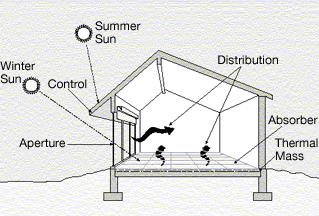|
Building Engineering Physics
The term building engineering physics was introduced in a report released in January 2010 commissioned by The Royal Academy of Engineering (RAeng). The report, entitled ''Engineering a Low Carbon Built Environment: The Discipline of Building Engineering Physics'', presents the initiative of many at the Royal Academy of Engineering in developing a field that addresses our fossil fuel dependence while working towards a more sustainably built environment for the future. The field of building engineering physics combines the existing professions of building services engineering, applied physics and building construction engineering into a single field designed to investigate the energy efficiency of old and new buildings. The application of building engineering physics allows the construction and renovation of high performance, energy efficient buildings, while minimizing their environmental impacts. Building engineering physics addresses several different areas in building performa ... [...More Info...] [...Related Items...] OR: [Wikipedia] [Google] [Baidu] |
Royal Academy Of Engineering
The Royal Academy of Engineering (RAEng) is the United Kingdom's national academy of engineering. The Academy was founded in June 1976 as the Fellowship of Engineering with support from Prince Philip, Duke of Edinburgh, who became the first senior fellow and remained so until his death. The Fellowship was incorporated and granted a royal charter on 17 May 1983 and became the Royal Academy of Engineering on 16 March 1992. It is governed according to the charter and associated statutes and regulations (as amended from time to time). History Conceived in the late 1960s, during the Apollo space program and Harold Wilson's espousal of "white heat of technology", the Fellowship of Engineering was born in the year of Concorde's first commercial flight. The Fellowship's first meeting, at Buckingham Palace on 11 June 1976, enrolled 126 of the UK's leading engineers. The first fellows included Air Commodore Sir Frank Whittle, the jet engine developer, the structural engineer Sir Ove Arup ... [...More Info...] [...Related Items...] OR: [Wikipedia] [Google] [Baidu] |
Fossil Fuel
A fossil fuel is a hydrocarbon-containing material formed naturally in the Earth's crust from the remains of dead plants and animals that is extracted and burned as a fuel. The main fossil fuels are coal, oil, and natural gas. Fossil fuels may be burned to provide heat for use directly (such as for cooking or heating), to power engines (such as internal combustion engines in motor vehicles), or to generate electricity. Some fossil fuels are refined into derivatives such as kerosene, gasoline and propane before burning. The origin of fossil fuels is the anaerobic decomposition of buried dead organisms, containing organic molecules created by photosynthesis. The conversion from these materials to high-carbon fossil fuels typically require a geological process of millions of years. In 2019, 84% of primary energy consumption in the world and 64% of its electricity was from fossil fuels. The large-scale burning of fossil fuels causes serious environmental damage. Over 80% of t ... [...More Info...] [...Related Items...] OR: [Wikipedia] [Google] [Baidu] |
Building Services Engineering
Building services engineering is a professional engineering discipline that strives to achieve a safe and comfortable indoor environment whilst minimizing the environmental impact of a building. Alternative titles are "building services engineering (BSE)"; also known as "MEP" ( Mechanical, Electrical and Plumbing), an emerging branch of engineering"; "technical building services"; and "building engineering" or "facilities and services planning engineering". The term building services engineering is widely used in Commonwealth countries (incl. United Kingdom, Ireland, Canada and Australia), but in the United States of America, In Asian countries Saudi Arabia and Pakistan, the MEP engineers are known as "services planners". In some countries, a "building services engineer" is a Senior MEP engineer with experience in the installation of equipment in Buildings Construction, Building Maintenance, Management, integration of electrical, mechanical, fire, hydraulic, security and communic ... [...More Info...] [...Related Items...] OR: [Wikipedia] [Google] [Baidu] |
Applied Physics
Applied physics is the application of physics to solve scientific or engineering problems. It is usually considered to be a bridge or a connection between physics and engineering. "Applied" is distinguished from "pure" by a subtle combination of factors, such as the motivation and attitude of researchers and the nature of the relationship to the technology or science that may be affected by the work. Applied physics is rooted in the fundamental truths and basic concepts of the physical sciences, but is concerned with the utilization of scientific principles in practical devices and systems, and in the application of physics in other areas of science and high technology. Examples of research and development areas *Accelerator physics *Acoustics *Atmospheric physics *Biophysics * Brain–computer interfacing *Chemical physics *Differentiable programming **Artificial intelligence **Scientific computing *Engineering physics **Chemical engineering **Electrical engineering ***Elec ... [...More Info...] [...Related Items...] OR: [Wikipedia] [Google] [Baidu] |
Building Performance
Building performance is an attribute of a building that expresses how well that building carries out its functions. It may also relate to the performance of the building construction process. Categories of building performance are quality (how well the building fulfils its functions), resource saving (how much resource is needed to fulfil its functions) and workload capacity (how much the building can do). The performance of a building depends on the response of the building to an external load or shock. Building performance plays an important role in architecture, building services engineering, building regulation, architectural engineering and construction management. Prominent building performance aspects are energy efficiency, thermal comfort, indoor air quality and daylighting. Background Building performance has been of interest to humans from the very first shelters built to protect us from the weather, natural enemies and other dangers. Initially design and performance we ... [...More Info...] [...Related Items...] OR: [Wikipedia] [Google] [Baidu] |
Energy Conservation
Energy conservation is the effort to reduce wasteful energy consumption by using fewer energy services. This can be done by using energy more effectively (using less energy for continuous service) or changing one's behavior to use less service (for example, by driving less). Energy conservation can be achieved through energy efficiency, which has a number of advantages, including a reduction in greenhouse gas emissions, a smaller carbon footprint, and cost, water, and energy savings. Energy conservation is an essential factor in building design and construction. It has increased in importance since the 1970s, as 40% of energy use in the U.S. is in buildings. Recently, concern over the effects of climate change and global warming has emphasized the importance of energy conservation. Energy can only be transformed from one form to another, such as when heat energy is converted into vehicle motive power or when water flow's kinetic energy is converted into electricity in hydroelectr ... [...More Info...] [...Related Items...] OR: [Wikipedia] [Google] [Baidu] |
Building Engineering
Architectural engineers apply and theoretical knowledge to the engineering design of buildings and building systems. The goal is to engineer high performance buildings that are sustainable, economically viable and ensure the safety health. Architectural engineering, also known as building engineering or architecture engineering, is an engineering discipline that deals with the technological aspects and multi-disciplinary. The responsibilities of an architectural engineer are designs, analyzing, and altering plans, or structures. They also assist team members with project objectives budgets and timelines. What it is required to be an architectural engineer is a bachelor's degree master's degree or/and professional engineering license and current knowledge of industry trends, technology, codes and regulation. From reduction of greenhouse gas emissions to the construction of resilient buildings, architectural engineers are at the forefront of addressing several major challenges of t ... [...More Info...] [...Related Items...] OR: [Wikipedia] [Google] [Baidu] |
Environmental Design
Environmental design is the process of addressing surrounding environmental parameters when devising plans, programs, policies, buildings, or products. It seeks to create spaces that will enhance the natural, social, cultural and physical environment of particular areas. Classical prudent design may have always considered environmental factors; however, the environmental movement beginning in the 1940s has made the concept more explicit. Environmental design can also refer to the applied arts and sciences dealing with creating the human-designed environment. These fields include architecture, geography, urban planning, landscape architecture, and interior design. Environmental design can also encompass interdisciplinary areas such as historical preservation and lighting design. In terms of a larger scope, environmental design has implications for the industrial design of products: innovative automobiles, wind power generators, solar-powered equipment, and other kinds of equipment ... [...More Info...] [...Related Items...] OR: [Wikipedia] [Google] [Baidu] |



